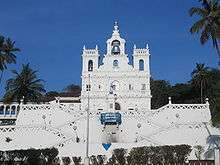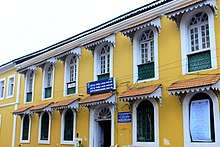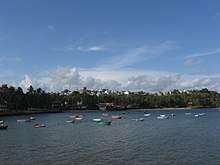Panaji
| Panaji Panjim Pangim | |
|---|---|
| Town | |
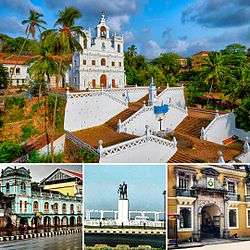 Anticlockwise from the Top: 1. Igreja da Nossa Senhora da Imaculada Conceição 2. Typical Portuguese influenced architecture. 3. Statue of Hindu-Christian Unity 4. Entrance to the Goa Police HQ | |
 Panaji Location of Panjim in Goa  Panaji Panaji (India) | |
| Coordinates: 15°29′56″N 73°49′40″E / 15.49889°N 73.82778°ECoordinates: 15°29′56″N 73°49′40″E / 15.49889°N 73.82778°E | |
| Country |
|
| State | Goa |
| District | North Goa |
| Sub-district | Ilhas de Goa |
| Elevated to Capital | 1843 |
| Government | |
| • Mayor | Vithal Dayanand Chopdekar |
| • Deputy Mayor | Asmita Kerkar |
| • Member of the Legislative Assembly of Goa | Manohar Parrikar (BJP) [1] |
| Area | |
| • Town | 21.01 km2 (8.11 sq mi) |
| • Metro | 76.3 km2 (29.5 sq mi) |
| Elevation | 7 m (23 ft) |
| Population (2011) | |
| • Town | 40,017 [2] |
| • Rank | 3rd in Goa |
| • Metro | 114,759[3] |
| Demonym(s) | Ponnjekar, Panjimites, Panajikar |
| Time zone | UTC+5:30 (IST) |
| PIN | 403 00x |
| Telephone code | 0832 |
| Vehicle registration | GA-01, GA-07 |
| Website |
www |
Panaji /ˈpʌnədʒi/ also known as Panjim, (Portuguese: Pangim) is the capital of the Indian state of Goa and the headquarters of North Goa district. It lies on the banks of the Mandovi River estuary in the Ilhas de Goa sub-district (taluka). With a population of 114,759 in the metropolitan area, Panjim is Goa's largest Urban agglomeration, ahead of Margão and Vasco da Gama.
Panjim has terraced hills, concrete buildings with balconies and red-tiled roofs, churches, and a riverside promenade. There are avenues lined with gulmohar, acacia and other trees. The Baroque Our Lady of the Immaculate Conception Church is located overlooking the main square known as Praça da Igreja. Panjim has been selected as one of hundred Indian cities to be developed as a smart city under the Smart Cities Mission.
This city of stepped streets and a seven kilometre long promenade was built on a planned grid system after the Portuguese relocated the capital form Velha Goa in the 17th century.[4] It was elevated from a town to a city on March 22, 1843 making it the oldest civic institution in Asia (175 years).[5]
Etymology
The city's present official name is Panaji. The Portuguese name was Pangim, although officially named Nova Goa. The city is popularly also called Panjim (in English). It has been renamed Panjim since the 1960s after the Indian administration – in an effort to wipe out all Portuguese influence from the State.[6] The city is called Ponnjé in Konkani.
Earlier a small village on the river front, in 1843 the city had been renamed Nova Goa (Portuguese for "New Goa") when it officially replaced the city of Goa (now Old Goa) as the capital of Portuguese India, though the Viceroy had already moved there in 1759.
The justification of the modern word Panaji is derived from the words panjani and khali, which mean a boat and a small creek respectively, in Sanskrit. Thus the modern word Panjim is believed to be a corruption of the old word Panjanakhani as inscribed on the discovered Panjim copper-plates dated 1059 CE, belonging to the rule of Kadamba king Jayakesi I.[7][8] According to legend, this northern capital city was mentioned in a stone inscription of Kadamba king Jayakesi I dated 1054 CE as 'Panjanakhani', giving him the epithet of Padavalendra which is Kannada for lord of the western ocean.[9]
History
Panjim was annexed by India with the rest of Goa and the former Portuguese territories after the Indian invasion of Portuguese India in 1961. It became a state-capital on Goa's elevation to statehood in 1987. Between 1961 and 1987, it was the capital of the Union Territory of Goa, Daman and Diu. A new Legislative Assembly complex was inaugurated in March 2000, across the Mandovi River, in Alto Porvorim. Panjim is also the administrative headquarters of North Goa district.
Geography
Panjim is located at 15°29′56″N 73°49′40″E / 15.49889°N 73.82778°E.[10] It has an average elevation of 7 metres (23 feet).
Demographics
During the 2011 census of India,[11] Panjim had a population of 114,405. Males constituted 52% of the population and females 48%. It had an average literacy rate of 90.9%; male literacy was 94.6% and female literacy 86.9%. In Panjim, 9.6% of the population was under 7 years of age.
Climate
Panjim features a tropical monsoon climate (Köppen climate classification Am). The climate in Panjim is hot in summer and equable in winter. During summers (from March to May) the temperature reaches up to 32 °C (90 °F) and in winters (from December to February) it is usually between 31 °C (88 °F) and 23 °C (73 °F).
The monsoon period is from June to September with heavy rainfall and gusty winds. The annual average rainfall is 2,932 mm (115.43 in).
| Climate data for Panaji (1971–1990) | |||||||||||||
|---|---|---|---|---|---|---|---|---|---|---|---|---|---|
| Month | Jan | Feb | Mar | Apr | May | Jun | Jul | Aug | Sep | Oct | Nov | Dec | Year |
| Record high °C (°F) | 36.6 (97.9) |
39.2 (102.6) |
39.0 (102.2) |
39.8 (103.6) |
38.6 (101.5) |
35.9 (96.6) |
32.3 (90.1) |
34.0 (93.2) |
33.2 (91.8) |
37.2 (99) |
37.2 (99) |
36.6 (97.9) |
39.8 (103.6) |
| Average high °C (°F) | 32.0 (89.6) |
31.7 (89.1) |
32.2 (90) |
33.1 (91.6) |
33.4 (92.1) |
30.3 (86.5) |
29.1 (84.4) |
28.7 (83.7) |
29.8 (85.6) |
31.8 (89.2) |
32.9 (91.2) |
32.7 (90.9) |
31.5 (88.7) |
| Daily mean °C (°F) | 26.0 (78.8) |
26.3 (79.3) |
27.7 (81.9) |
29.3 (84.7) |
30.0 (86) |
27.6 (81.7) |
26.7 (80.1) |
26.4 (79.5) |
26.9 (80.4) |
27.9 (82.2) |
27.6 (81.7) |
26.9 (80.4) |
27.4 (81.3) |
| Average low °C (°F) | 19.9 (67.8) |
20.7 (69.3) |
23.2 (73.8) |
25.5 (77.9) |
26.5 (79.7) |
24.8 (76.6) |
24.3 (75.7) |
24.0 (75.2) |
24.0 (75.2) |
23.9 (75) |
22.2 (72) |
21.0 (69.8) |
23.3 (73.9) |
| Record low °C (°F) | 14.4 (57.9) |
13.3 (55.9) |
17.5 (63.5) |
19.4 (66.9) |
20.9 (69.6) |
20.9 (69.6) |
20.5 (68.9) |
21.7 (71.1) |
21.0 (69.8) |
20.0 (68) |
15.3 (59.5) |
15.7 (60.3) |
13.3 (55.9) |
| Average precipitation mm (inches) | 0 (0) |
0 (0) |
1 (0.04) |
5 (0.2) |
56 (2.2) |
861 (33.9) |
853 (33.58) |
622 (24.49) |
237 (9.33) |
111 (4.37) |
35 (1.38) |
2 (0.08) |
2,813 (110.75) |
| Average rainy days (≥ 1.0 mm) | 0.0 | 0.1 | 0.1 | 0.6 | 3.8 | 24.0 | 28.2 | 27.2 | 14.9 | 6.6 | 3.5 | 0.3 | 109.3 |
| Average relative humidity (%) | 67 | 69 | 71 | 71 | 71 | 85 | 88 | 89 | 86 | 80 | 70 | 64 | 76 |
| Mean monthly sunshine hours | 311.8 | 290.2 | 291.0 | 289.0 | 296.5 | 125.1 | 105.7 | 122.1 | 177.1 | 247.7 | 272.6 | 299.3 | 2,828.1 |
| Source #1: NOAA[12] | |||||||||||||
| Source #2: India Meteorological Department (record high and low up to 2010)[13] | |||||||||||||
Landmarks
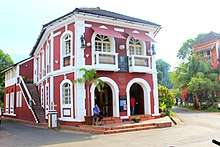
The heart of the city is the Praça da Igreja (Church Square) where the Jardim Garcia de Orta (municipal garden) with the Portuguese Baroque Igreja da Nossa Senhora da Imaculada Conceição, originally built in 1541. Other tourist attractions include the old and rebuilt Adilshahi Palace (or Idalção Palace), dating from the sixteenth century, the Institute Menezes Braganza, the Mahalaxmi Temple, the Jama Masjid Mosque, the Chapel of St. Sebastian and the Fontainhas area—which is considered to be the old Latin Quarter—as well as the nearby beach of Miramar. Hanuman Mandir at Malā on the hill top (Altinho) and its annual zatrā in February are a major attraction of Panjim. Panjim hosted the relics of Saint John Bosco (also known as Don Bosco) till 21 August 2011 at the Don Bosco Oratory.
The carnival celebrations in February include a colourful parade on the streets. This is followed by the Shigmo/xigmo, or Holi. The Narkāsūr parade on the night before Diwali in the city is very colourful.
Well-known places in Panjim are the 18th June Road (a busy thoroughfare in the heart of the town and a shopping area for tourists and locals), Mala area, Miramar beach and the Kala Academy (a cultural centre known for its structure built by architect Charles Correa). Kala Academy is a place where Goa showcases its art and culture.
Adil Shah's Palace
Situated on the banks of Mandovi River in the heart of Panjim is ‘Old Secretariat’ building popularly known as ‘Adil Shah’s Palace’.[14] In 1500’s the Portuguese conquerors renamed it as ‘Idalcao’s Palace’ [15]and was the temporary residence of the first ‘Viceroy of Goa’. In 1963 this ancient structure was renovated by Goa Government to house Goa Legislative Assembly. This Structure today is 'The Goa State Museum'.
Other attractions
Salim Ali Bird Sanctuary is a bird sanctuary named after the ornithologist Dr Salim Ali. The sanctuary, located in the village of Chorão, near Panjim, plays host to rare and endangered bird species—both migratory and resident.
Goa is famous for its beaches, and Miramar, Bambolim, and Dona Paula are three popular beaches located near Panjim.
Dona Paula is the meeting point for two of Goa’s famous rivers, Zuari and Mandovi. These two rivers meet at the Arabian Sea. The official residence of the Governor of Goa, known as Cabo Raj Bhavan, is situated on the westernmost tip of Dona Paula.
Miramar Beach is one of the more crowded beaches in Goa, which remains full with local and international tourists throughout the year.
Also located near Panjim, is the Goa Science Centre which was opened to the public in December 2001. The Caculo Mall is also located in St. Inez near Panjim. Also Madhuban Complex, at St.inez is very popular among Panjimites.
Education
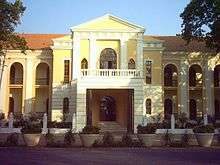
There is only one university in Goa, the Goa University, which is situated at Taleigão on the outskirts of Panjim.
Research centres
The National Institute of Oceanography (CSIR-NIO) is situated at Dona Paula, on the outskirts of Panjim city. It specialises in marine science research.
Transport
The nearest airport is Dabolim Airport which is 30 kilometres (19 miles) away.[16]
Media and communications
State-owned All India Radio has a local station in Panjim which transmits various programs of mass interest.
Governance
The Goa government, as well as the Indian government, has its major offices in Goa.
- Bombay High Court – Goa bench
- Goa Education Development Corporation
- Industrial Development Corporation Goa
- Junta House – houses government offices
- Passport Office, Panjim
- Press Information Bureau (Government of India's Press Office)
- Sports Authority of Goa
- All India Radio, Altinho
- Doordarshan Complex, Altinho
The Goa Legislative Assembly is situated at Alto Porvorim, about 2 km (1.2 mi) from Panjim. The hillock called Altinho houses some major central government offices and the residences of prominent officials and politicians.
Politics
The Member of Legislative Assembly (MLA) for Panjim is Manohar Parrikar of the BJP is also the Chief Minister of Goa. The Corporation of the City of Panaji (CCP) administers the city and its Mayor is Vithal Dayanand Chopdekar.[17] Asmita Kerkar is the Deputy Mayor.[18][19][20]
The Governor of Goa stays at the Cabo Raj Bhavan at Dona Paula, about 8 km (5 mi) from Panjim. The Governor is Mridula Sinha.
Sports
Two of Goa's premier clubs Dempo S.C. and Sporting Clube de Goa are based in Panjim and they both compete in India's top tier league I-League. Clube Tennis de Gaspar Dias in Miramar was founded in the year 1926 and remains among the most sought after Tennis clubs in Goa. [21] The multipurpose Campal Indoor Complex is planned in Campal besides the existing football ground. The Don Bosco college football grounds on General Bernardo Guedes road has been long a long established sports field in the city.
International relations
Twin towns – Sister cities
Panjim is twinned with:
See also
References
- ↑ http://goavidhansabha.gov.in/member.php?id=161&flag=MLA&aid=7
- ↑ http://www.census2011.co.in/data/town/803243-panaji-goa.html
- ↑ http://www.census2011.co.in/census/metropolitan/414-panaji.html
- ↑ "Corporation of The City of Panaji :: Official Site". ccpgoa.com. Retrieved 2018-05-07.
- ↑ "Panaji completes 174 years as state's capital city - Times of India". The Times of India. Retrieved 2018-05-07.
- ↑ http://www.heraldgoa.in/Edit/Opinions/Goa%E2%80%99s-silent-genocide/89034.html
- ↑ Title: Gazetteer of the Union Territory Goa, Daman and Diu: district gazetteer, Volume 1; Publisher: Gazetteer Dept., Govt. of the Union Territory of Goa, Daman and Diu, 1979 (Original from the University of Michigan, Digitised: 30 August 2008)
- ↑ "EPIGRAPHICAL AND LITERARY SOURCES ON WORSHIP IN GOA'S PAST" (PDF). ShodhGanga.
- ↑ De Souza, Teotonio R. (1990). Goa Through the Ages: An economic history, Volume 2. Concept Publishing Company. p. 129. ISBN 9788170222590.
- ↑ "Falling Rain Genomics, Inc – Panaji". Fallingrain.com. Retrieved 9 May 2012.
- ↑ "Provisional Population Totals Paper 2, Volume 2 of 2011: Goa State Tables" (PDF). censusindia.gov.in. Registrar General and Census Commissioner of India. Retrieved 9 July 2013.
- ↑ "Goa (Panjim) Climate Normals 1971–1990". National Oceanic and Atmospheric Administration. Retrieved 15 April 2015.
- ↑ "Ever recorded Maximum and minimum temperatures up to 2010" (PDF). India Meteorological Department. Archived from the original (PDF) on 21 May 2013. Retrieved 15 April 2015.
- ↑ "Adil Shah's Palace". Retrieved 10 Jan 2018.
- ↑ "Old Secretariat". Retrieved 10 Jan 2018.
- ↑ "Airports Authority of India". Aai.aero. 21 September 2011. Archived from the original on 21 April 2012. Retrieved 9 May 2012.
- ↑ https://web.archive.org/web/20180315124910/http://www.navhindtimes.in/chopdekar-is-ccp-mayor/
- ↑ https://web.archive.org/web/20180315124910/http://www.navhindtimes.in/chopdekar-is-ccp-mayor/
- ↑ https://web.archive.org/web/20180313213539/http://theneutralview.com/goa-vithal-chopdekar-asmita-kerkar-to-be-elected-unopposed-as-mayor-dy-mayor/
- ↑ https://web.archive.org/web/20180313213729/http://www.navhindtimes.in/chopdekar-is-ccp-mayor/
- ↑ "Club Tennis de Gaspar Dias - GoGoaNow !". GoGoaNow !. Retrieved 2018-05-07.
- ↑ "Acordos de Geminação, de Cooperação e/ou Amizade da Cidade de Lisboa" [Lisbon – Twinning Agreements, Cooperation and Friendship]. Camara Municipal de Lisboa (in Portuguese). Archived from the original on 31 October 2013. Retrieved 23 August 2013.
External links
| Wikimedia Commons has media related to Panaji. |

- Government of Goa
- "Places to Visit in Panjim", Tripoto, retrieved 2 November 2014
- Panaji Land Records
